Ag Can’t Wait
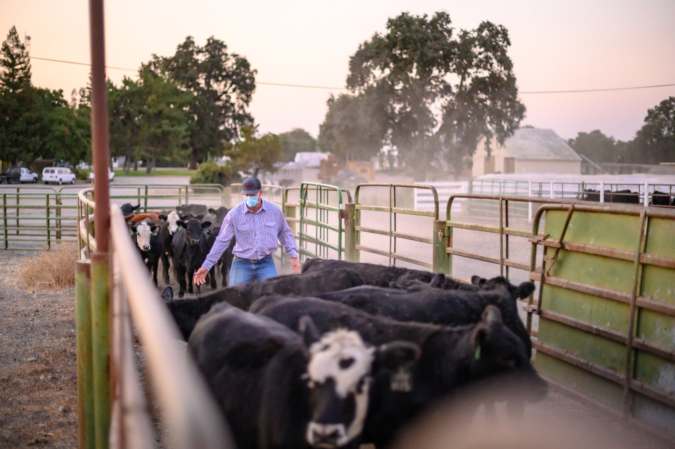
“We need to support our farms and ranches on all fronts so we can eat—we as a nation, we as a world, we as a community,” said Reed Pritchard, agricultural education major.
Student Essential Workers Maintain Farm Operations during Pandemic
Annelise Perez closes her apartment door and burrows into her hoodie against the morning chill. A Swine Unit ballcap holds hair back from her face as she tugs on black rubber boots and wipes the sleep from her eyes.
No time to waste. Her charges have already launched into their morning breakfast routine, squealing and grunting in a deafening cacophony that resounds through the darkness. No doubt, the pigs will wake her neighbors if she doesn’t heed their hungry call.
Gravel crunching underfoot, Perez walks to the sow barn, a mere 20 paces from where she was soundly sleeping minutes earlier, and grabs the wheelbarrow she loaded with feed the night before.
Sunrise still 90 minutes away, the agricultural education major starts tossing scoops of pellets with practiced expertise, and snuffling replaces the pigs’ chatter as they fill their bellies with breakfast. Moving to the nearby nursery, she runs her hand across grain in the troughs to make sure no one needs food. Just five weeks old, the piglets scatter when she approaches, skittishly falling over one another in a tangle of white, black, and red. Yet within a few weeks, she said, she can climb in with them and they will clamber all over her.
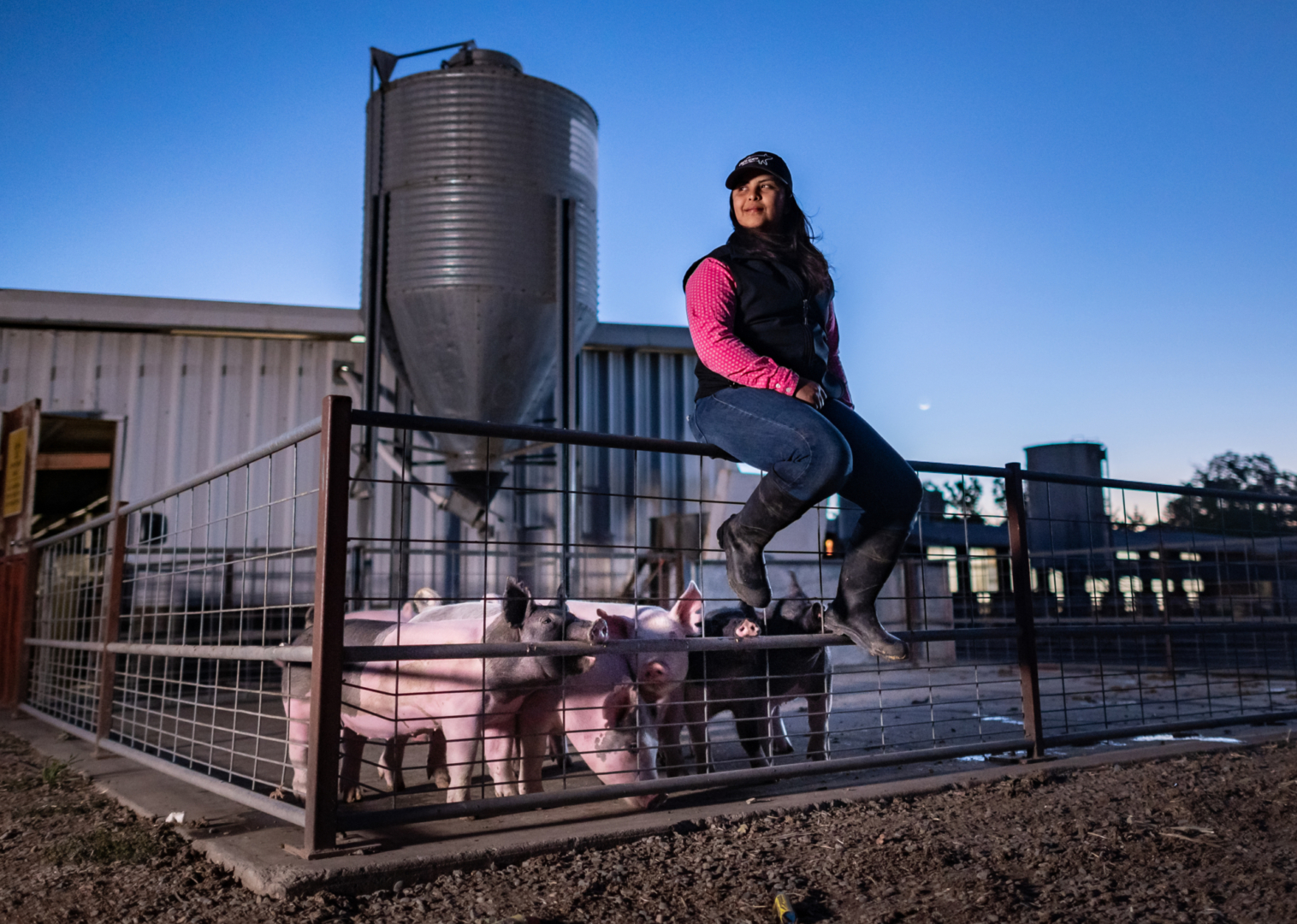
After 20 minutes spraying the floors clean, she makes her last stop at another barn to repeat the process.
“You get your steps in,” Perez said, as she follows the 150-pound pigs down the barn corridor to release them for some playtime. She relishes a momentary pause to watch them as they tussle and sniff, a few racing a tractor as it passes by.
“They are having a great time,” she said, with a laugh. “They have a great life.”
It’s one the Merced native is excited to take part in. Ever since assuming her role as part of the Swine Unit at the Paul L. Byrne University Farm in fall 2019, the senior has risen before dawn most mornings to care for more than 200 pigs. She feeds them, cleans pens, and checks who may be ready for breeding, birthing, or the butcher.
“When I become a teacher, I’ll have confidence in what I say and what I do because I’ve lived it,” said Perez, whose dream is to teach high schoolers with a similar soft spot for swine and encourage them toward careers in agriculture.
She’s grateful to have this chance to live and work on the farm. On these early mornings, the global pandemic is blissfully far from her thoughts, as not even COVID-19 could interrupt the farm’s extensive operations. By the time California moved most learning and working online, the Organic Dairy Unit’s 80 cows had already calved and needed twice-daily milking, seeds had been planted across 400 acres of row crops, and the orchards were setting five varieties of nuts and fruit.
“We definitely don’t have the mind frame that everything is on pause, because nothing is on pause,” said senior Saira Barajas, an agricultural education major who also lives and works on the farm. “The crops have to be picked and the cows have to be fed and the trees need to be watered, even if the world is on fire. People don’t realize that because we are a school farm, we are still helping the community.”
In addition to 15 full-time employees and a handful of supervising faculty members, more than 50 students work on the farm in some capacity. Due to federal and state designation as essential operations at the beginning of the COVID-19 pandemic, most of the students have continued their critical roles caring for the land, the plants, and the animals the College of Agriculture stewards.
“They aren’t just a student employee. It’s part of their education, it’s part of what we do,” said farm manager and professor Dave Daley (Agriculture, ’79). “The staff and students today are just as passionate about this place as when it first began. They care and they work really hard because they are proud of it.”
And yet, to those outside of the students’ agricultural circles, few—including their friends and families—seem to understand why they are still hard at work.
“People very rarely, in my opinion, think about where their groceries come from and even less so think about who picks their cherries, who raised their beef, and are they able to maintain safety in their workplace during a global pandemic,” said senior Reed Pritchard. “A simple solution to this comes down to education, and that’s what my passion is and that’s why I’m here.”
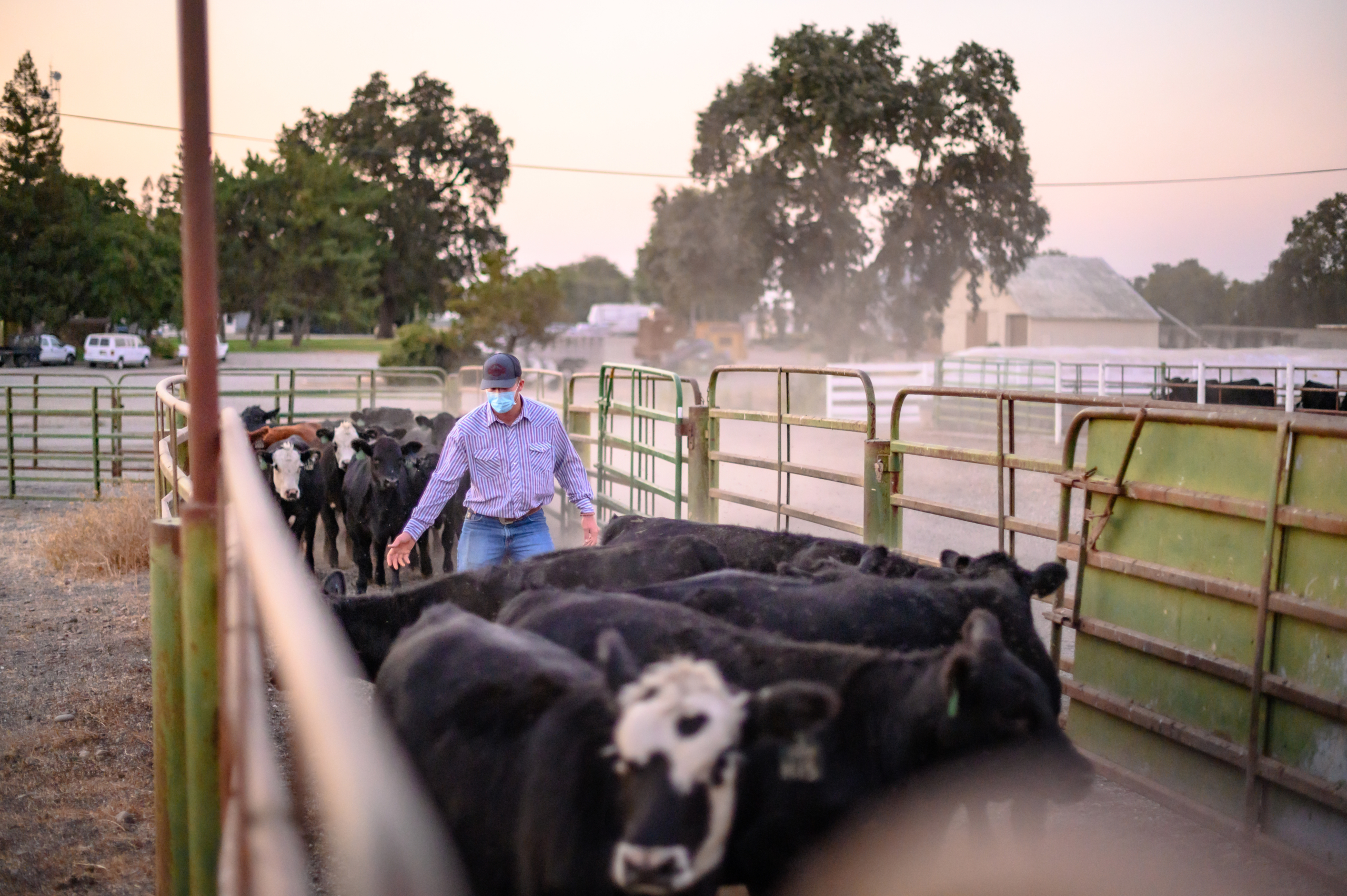
He began dreaming about attending Chico State when he was a child, growing up on a cattle ranch in Flournoy, 45 miles northwest of Chico.
“It may be my bias and pride talking, but Chico State has the most impressive, most well-rounded, and most efficient farm in the CSU system and in large parts of the United States,” Pritchard said.
He has been proud to spend his junior and senior years living and working in a place that “feels exactly like home.” As student lead at the Beef Unit, he rises shortly after Perez for his shift managing 120 head of cattle from birth to butcher shop.
“It’s a lot of doctoring cattle, watching and maintaining health, a lot of feeding,” he said. “It’s a lot of decision-making because you are working on your own. Really knowing and understanding the livestock that we work with is the most constant thing you can do on this farm.”
He starts his day mixing feed rations and inspecting the herd. Gates clang behind him as he walks amongst the calves, making sure no one seems lethargic or limps as they scamper around him, kicking up clouds of dirt.
“To be able to take ownership of the livestock we have here—care for them professionally and practically, and efficiently and sustainably—is so rewarding in and of itself,” Pritchard said.
It takes nearly two hours to feed and check the herd, and then he moves on to the day’s projects, whether vaccination, weaning calves, hauling cows to sale, or welding pens and maintaining facilities.
“You could spend all day every day out here finding tasks to do,” said Pritchard, who balances his workload with 22 units of classes this fall.
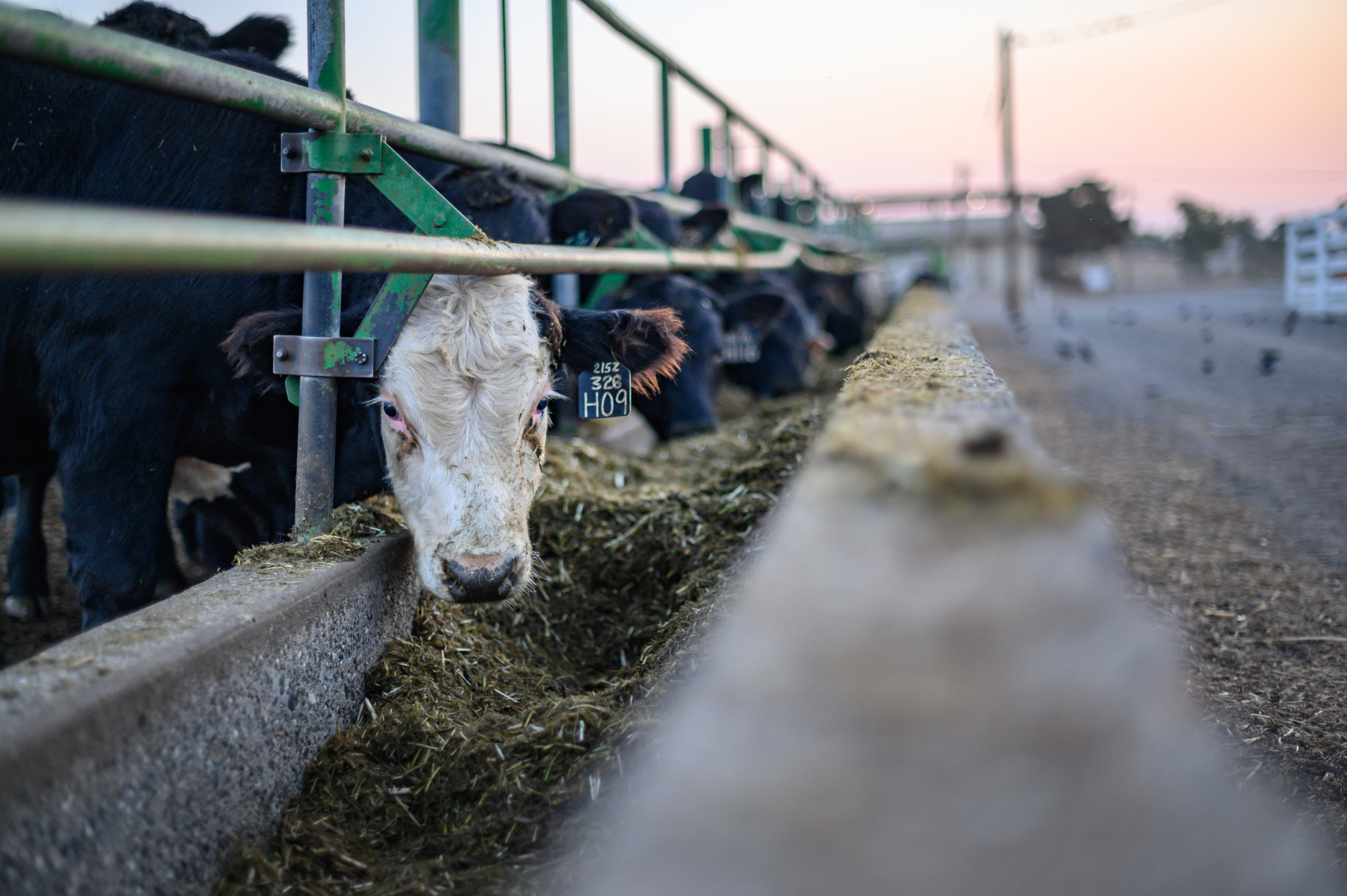
Like Perez, his dream is to work in ag education, teaching other young people about the power and critical need of agriculture.
“Of all commodities that an agriculturalist could possibly work with—from grain crops to livestock to anything involving mechanics fabrication to the multibillion-dollar industry of almonds—the greatest commodity that we can grow is our young people,” he said. “Our young people need cultivation, they need guidance, they need tender loving care like all other commodities. It’s truly my passion to help produce effective young people to carry on legacies of farms and ranches and be good productive citizens.”
Pritchard is particularly motivated by nationwide labor shortages on farms and ranches, which so critically depend on high school and college students to pursue agriculture for their careers.
“We need to support our farms and ranches on all fronts so we can eat—we as a nation, we as a world, we as a community,” Pritchard said.
With all they have learned so far and all they aspire to do with their careers, the student employees know they are needed perhaps now more than ever, said Organic Dairy herd manager Darby Heffner (Animal Science, ’06).
Regional farmers and ranchers are engaged with the farm’s research trials, seeds are exported to international markets, and nuts and grains are sold to buyers throughout the area. Livestock and produce are sold to locals via the on-farm Meats Lab and Organic Vegetable Project, and milk from the dairy makes its way onto store shelves all over the West Coast.
The dairy cows had just finished calving in March, and it would have been impossible to cease their milk production to halt operations when COVID-19 struck. And even though milk prices dropped drastically in the early days of the pandemic, they have since surged, as those working and learning from home are consuming more than ever.
“The students said, ‘I’ll be here at 5 a.m. for milking, no problem.’ They are here pulling milk shifts on the weekends,” Heffner said. “They take ownership of this place, and it’s pretty awesome. They take care of the cows and the crops like they are their own.”
Even though Barajas’ background was in livestock, the Modesto native took a job in the Crops Unit because working and living on the farm in any capacity had been her dream since eighth grade.
“People think you don’t have to go to college for ag or that ag is something you do if you don’t go to college,” she said. “That’s a question I’m asked all the time—‘Why are you wasting time and money to go to college?’ I ask them, ‘What do you know about ag?’ And they have no answers.”
While her mom grew up on a dairy and her parents worked in farm labor for a while, Barajas said she’s always been surrounded by people who don’t understand the essential nature of agriculture—an industry that employs nearly 830,000 people in California and millions across the nation.
Educating others is what drives her dream to be the first in her family to graduate from a four-year university and become a high school agriculture teacher.
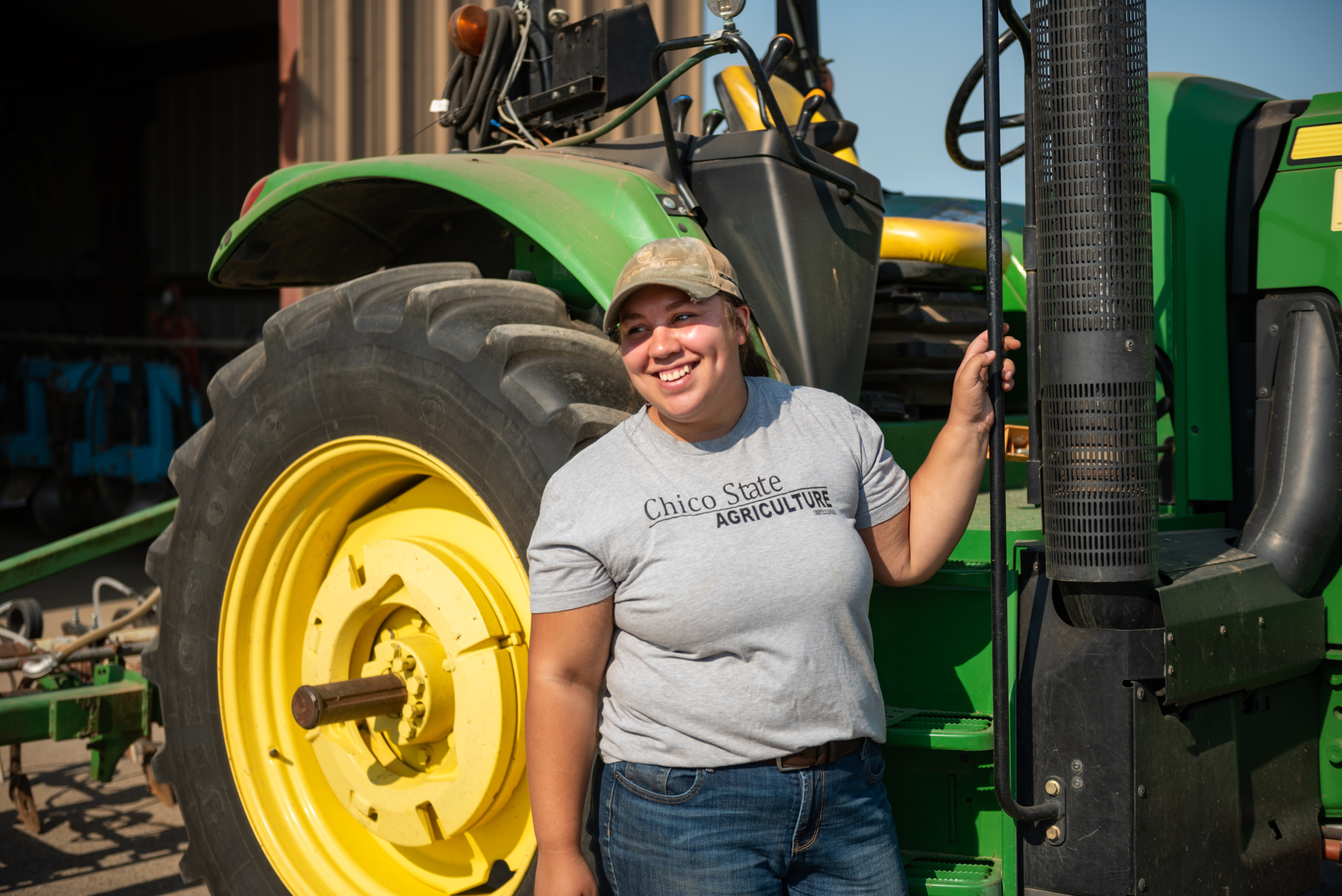
Once she was exposed to crops, Barajas quickly fell in love and decided to focus on plant science. After her online morning classes for the 21 units she is taking this semester, by noon she is eager to get outside and get her hands dirty. Retrieving a tractor from across the farm, she parks it outside the shop and climbs down, standing alongside rear tires taller than her while she waits for the day’s instructions.
Unlike the routines of those in the livestock units, the roles of students in the Crops Unit vary season to season and even day to day. This summer, she picked peaches, laid irrigation line, and worked on tractors. By fall, she was running the nut elevator during almond harvest and working the walnuts.
In addition to supporting the local nut, grain, and produce markets, and producing corn, hay, and alfalfa to feed its own livestock, the farm produces seeds for export as far as Italy —and students have a role in it all..
On this morning, Barajas has to prepare the tractor for plowing the fields so they are ready for planting before fall rains come. She measures between the tractor’s shanks to figure out what plates they will need and swaps out gaskets, flipping through pages of a book and calculating numbers in her head to ensure she has the right size and quantity.
“Since I’ve worked in the Crops Unit, I’ve been exposed to so much more and it opens a lot of doors,” she said. “I feel more confident in applying for the credential program, and I know I totally have what it takes to provide my future students with the knowledge they need.”
When her shift is over, she studies for a few more hours and then takes a break to walk the farm, listening to the breeze in the orchards and the soft bleating of lambs in the Sheep Unit pastures.
She might pull weeds while she walks, take note of a broken irrigation line, or help a fellow student who’s experiencing a hiccup with equipment.
“Something always has to be done, every single day, at all times of the day. Even after the work shift is over, there is always something that could be done,” Barajas said. “We don’t have that sense of having to keep ourselves entertained or keep our minds busy. As students working on the farm, we are thinking of this essay that’s due and this project to start. And after that, I have to go check the sprinklers and make sure the tractor in D1 is still working or the GPS is OK.”
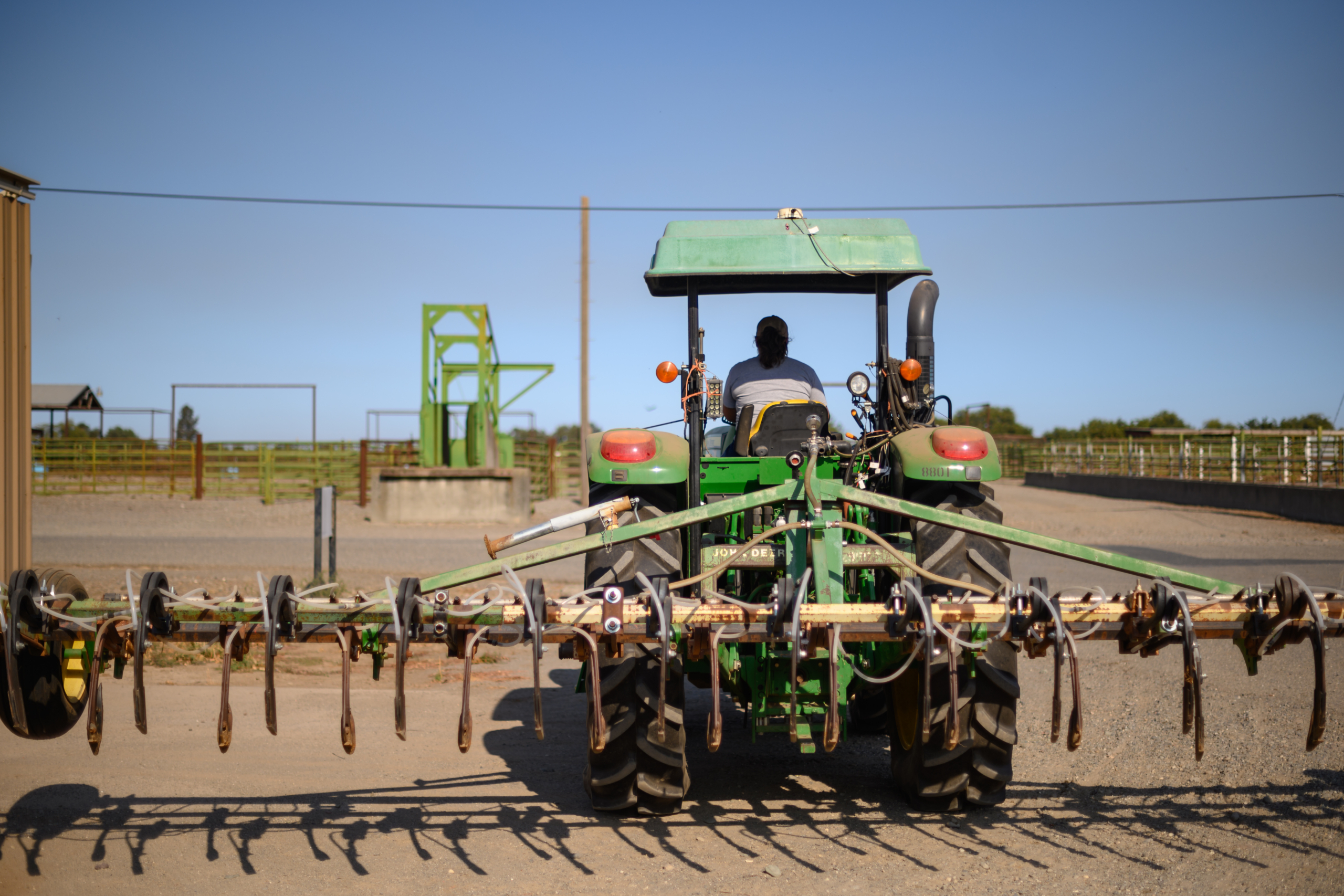
Like Perez, Barajas said the workload and environment keep the stress of the pandemic far from her mind.
In many ways, the farm is where Barajas feels safest. After battling non-Hodgkin’s lymphoma during her early years of college, she knows she is more vulnerable than her peers to the dangers of COVID-19, but the farm protocols and sense of community give her comfort. If work brings them together, they wear masks if they can’t socially distance. Routine cleaning, already critical for food safety and production, has become even more imperative.
Safety is paramount, Barajas and the other students say, not only for their own health but the care and well-being of the animals and crops.
“With everything going on, we try to stay as sanitized and safe as possible,” Pritchard said. “There is no more than a handful of us that work on the Beef Unit. It’s not hard for five people to spread a virus. If all five of us are out of commission and can’t work, who is going to feed the cattle until we are ready to come back to work? We need to be extra careful so that we can continue to fulfill our essential duties to keep our livestock healthy and happy and in the best condition they can be.”
Of course, the farm is a little quieter these days without the usual lab classes, small research projects, and tours, which are typically held several days a week for prospective students and elementary and high school kids.
And COVID-19 has brought other challenges. For such an in-person discipline, engaging students in lab activities the way they have historically is hard to replicate—but that doesn’t mean they aren’t trying.
Every Thursday, a professor comes to the Meats Lab to film the butchering of various livestock, capturing different angles and techniques to show students watching via their laptops, recreating the experience virtually as best as possible. How-to videos for calibrating tractors and utilizing GPS are distributed to students to study, along with test results for a research project on an experimental fava bean crop and another on muscle-development supplements in the Sheep Unit.
As classes take place all day, via Zoom, the essential work on the farm continues in tandem.
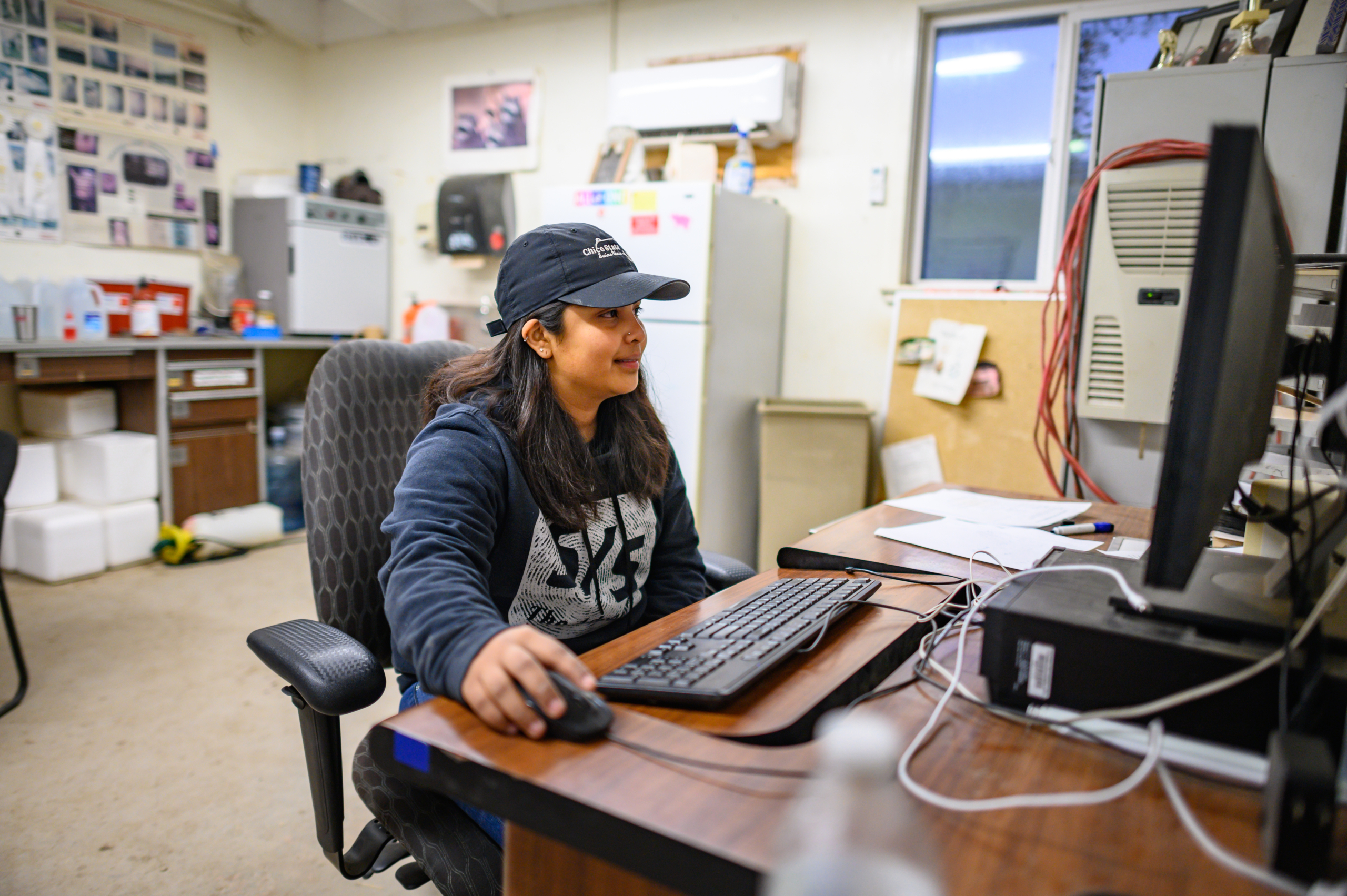
The sky begins to turn from blue to shades of sherbet, the sun disappears below the oak trees, and operations wind to a standstill. The sound of rumbling tractors and nut elevators gives way to the gentle rustle of leaves in the orchards, and the lowing of cattle. Student residents are in their apartments and trailers, doing homework or sitting through evening classes. A few gather together for dinner or make a run to town for groceries before returning to studying.
Around 10 p.m., Perez, who is taking 19 units this semester, has finished her homework for the day. She closes her laptop and reaches for her boots. Even though it’s not among her designated tasks, she likes to unwind with one final walk through the pig barns before bed.
“If I can catch them sleeping when I walk through, if I’m quiet, I can catch any heavy breathing, wheezing, or health issues. If I notice an injury, I can treat it then and there instead of waiting until morning,” she said. “It’s nice having eyes out here all the time.”
Her shadow dances along the wall of the barn as she listens to the soft slumbering. Her next visit is the piglets, where she can’t help but smile at how perky they are no matter the hour. The sows are her final stop. A few are close to going into labor, but after a quick check, she is confident she can sleep through the night. The babies won’t come for another day or so, and then she’ll probably help with farrowing around the clock. She’ll embrace her rest now while she can.
With that, Perez pulls the barn door closed and heads to bed. In another seven hours, the sows will start their morning song, and she’ll repeat her routine all over again.
“There are so many opportunities to learn out here,” she said. “There’s no place I’d rather be.”
As the University Farm looks toward the next 60 years and beyond, we are excited to build a new farm store and educational center that will further hands-on learning opportunities and support our farmers and community. With your support, we can raise enough funds by 2022 to make this vision possible.
Turn your gift into impact at www.csuchico.edu/ transformtomorrow.


